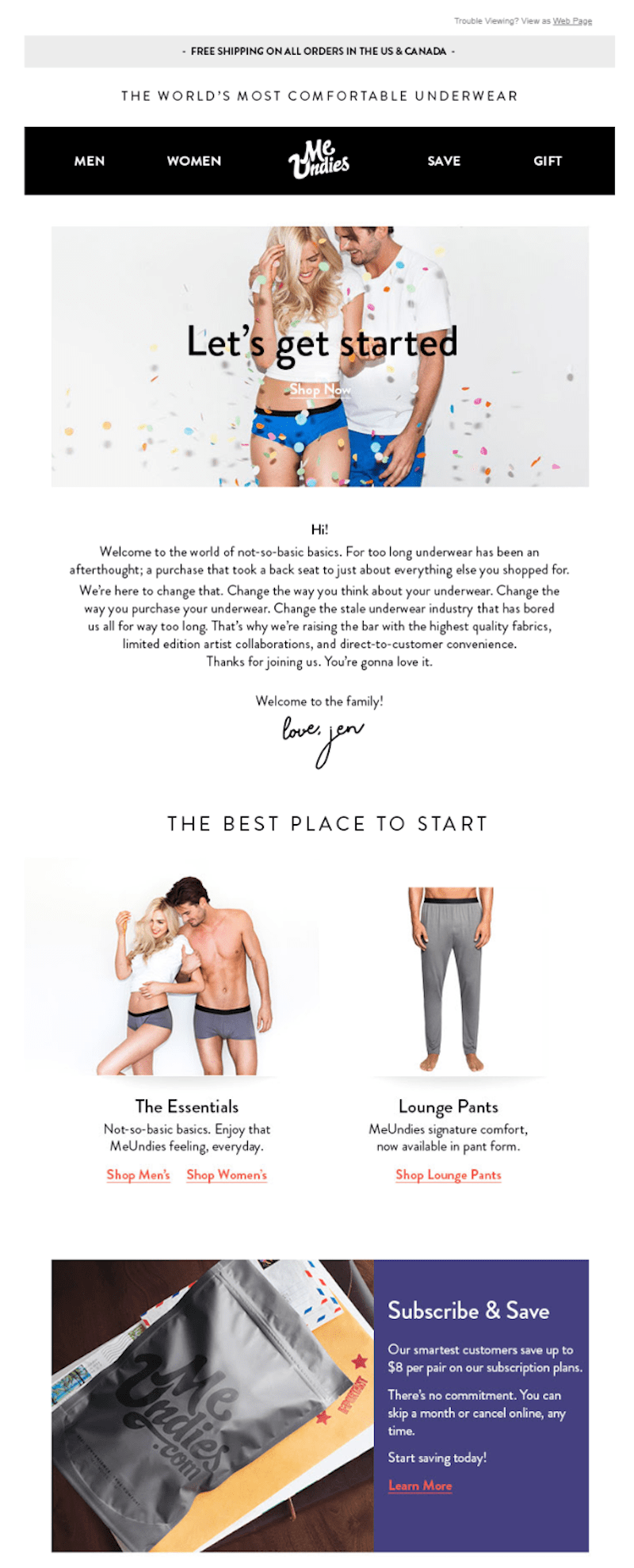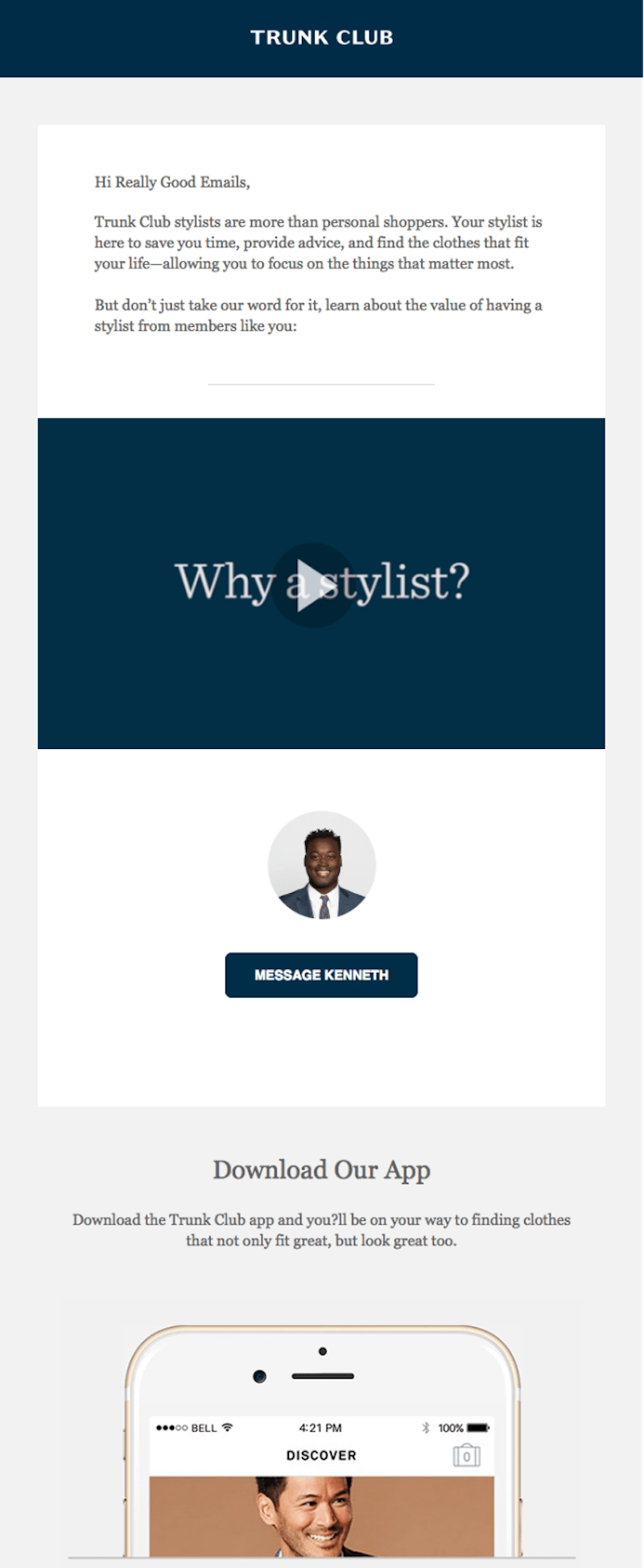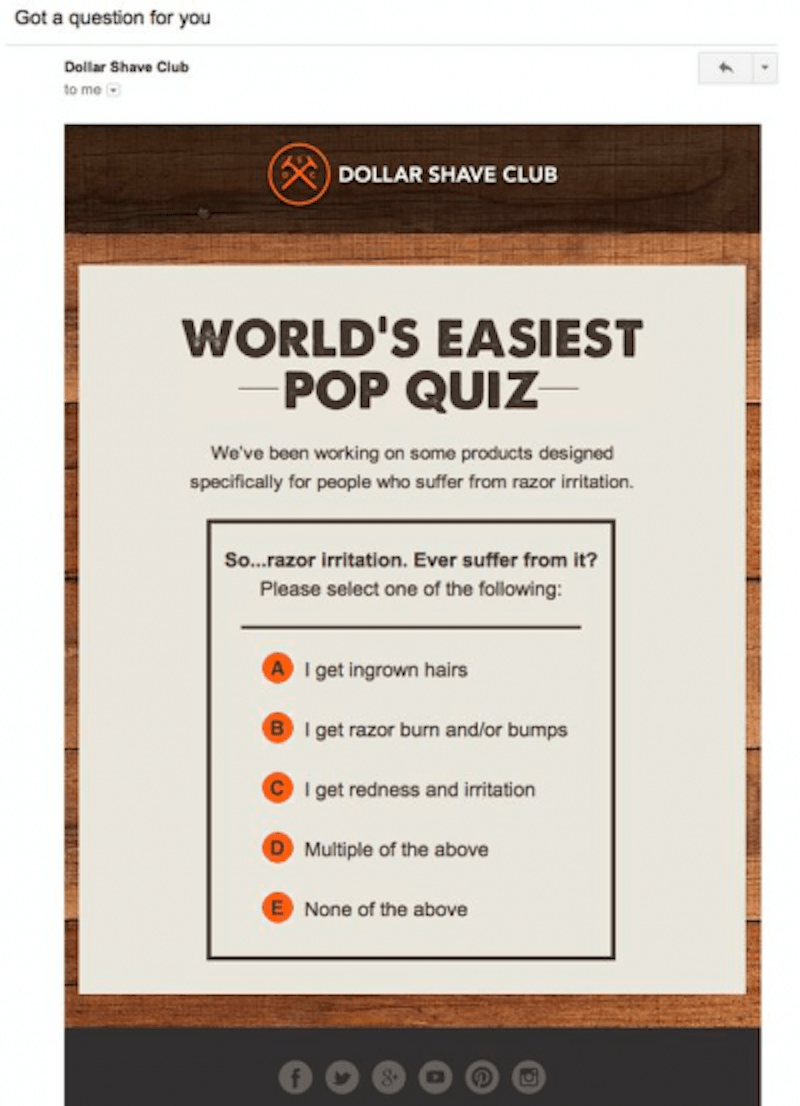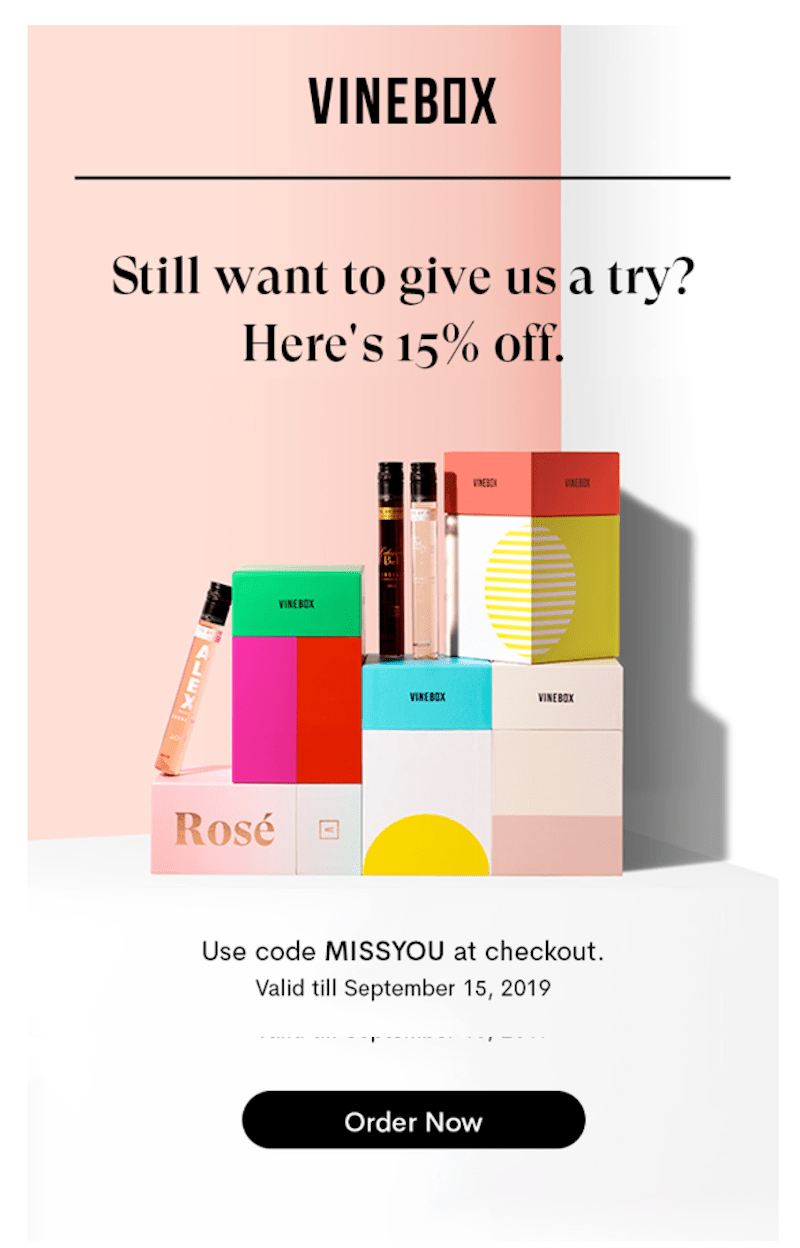A growing number of ecommerce businesses have oriented themselves towards a subscription-based model. They offer customers to pay a fixed monthly amount (or quarterly or even annual), and in turn receive a regular delivery of products. This way, they create a loyal and returning customer base and are able to collect an increasing amount of data on them, constantly improving their offer.
In order to put this in perspective, from 2011 to 2016, subscription-based ecommerce increased revenue from $57 million to $2.7 billion. This growth is almost unprecedented and is only continuing, as more and more businesses get in on the action. Chances are your next client may very well be a subscription-based ecommerce business.
In this article, we look at five unique email marketing tactics to help your subscription-based clients acquire new customers and grow their customer base.
What is subscription-based ecommerce?
But first, to truly help your clients with subscription businesses, it’s important to understand what exactly a subscription-based business is.
A subscription-based business model has several distinct advantages over traditional pay-per-product models. In the first place, owners are capable of better planning their revenue, costs, and inventory, making for regularity in orders. Secondly, they acquire loyal customers who will be there month after month, provided the quality of the offer is maintained and improved. Finally, constant interaction with customers allows a business to accumulate an increasing amount of information on the habits and preferences of their customers—information you can use to help your client improve their service and offer.
While these advantages are clear, not every type of product can be offered on a subscription basis. The model works best for products that have a regular pattern of consumption. This includes:
- The Replenishment Model: Businesses selling goods where the supply is naturally depleted, such as cosmetics, drinks, hygienic products, and some clothes
- The Curated Model: Businesses where goods are offered according to the preferences of the customer, such as for wines, coffee, and similar
- The Premium Account Model: Businesses where goods are offered at bargain prices or low delivery costs
You might also like: How to Build an Abandoned Cart Email Sequence.
Why email is critical to subscription-based businesses
Email represents one of the most efficient acquisitions and customer relations channels. According to studies, the average ROI of email campaigns is around $38. Since subscription-based businesses depend on a frequent and meaningful engagement of customers, email is a critical tool.
Email represents the fastest and most effective way to engage existing customers, offer them products, get feedback, provide information, and help curate recommendations to customers based on their preferences. Unlike traditional ecommerce stores, abandoned cart emails do not represent a major and critical component of email marketing for subscription business. Likewise, cross-selling is less important, since the product that is offered is a subscription itself. That means that running email campaigns for subscription businesses is a wholly unique challenge.
Want to optimize your one-on-one reach outs to these types of clients? Check out our article on the best business email format to use.
How to run an email marketing campaign for a subscription-based business
Promoting a subscription-based business is necessary to grow the business, increase the number of subscribers and by extension, revenue. There are five important aspects of marketing a subscription-based business:
- Acquire new customers
- Engage existing customers
- Turn regular customers into subscribers
- Gather additional information about customers
- Re-activate inactive customers
Any successful and effective email campaign for a client must address all these, and translate them into email messages.
1. Acquire new customers
As in every ecommerce business, acquiring new customers is the best way to gain new subscribers. Using email to present the features of subscription to a customer allows the business to present its unique value proposition, the benefits a subscriber gets by signing up, the terms and conditions of the offer, social feedback, and other trust indicators. This is likely the first campaign a client may want to run.
An initial or welcome email to new subscribers serves to show new subscribers what they can expect from the service, and to engage them with the business. Without a structured onboarding process, the typical retention rate for any sort of subscription hovers around 25 percent. An indispensable part of increasing that retention rate is email, and sending welcome emails helps set the tone of any future relationship with the customer.
For example, MeUndies, an underwear retailer that features a subscription-based service, sends a welcome email. The email contains a personal note from the company, and an explanation of how it all works. To make it easier for a prospect to sign up, there is a subscribe and save call-to-action button, leaving little to the imagination.
Additionally, to make the decision easier, there are links for men and women sections. The email includes assurance of free shipping and to remove any risk, the company offers a full money-back guarantee.

This welcome email makes it easy for a new customer to understand the offer and subscribe to the monthly or quarterly delivery of new underwear.
2. Engage existing customers
To be successful, a subscription-based business needs to constantly offer engagement to their customers. By maintaining the existing relationship and making it more engaging, you can help your client increase the average order value of their subscribers. The lifestyles of your client’s customers will change with time, so offering an option for buyers to update their subscription and add products is one way of engaging users.
A good example of this is an email sent by Bombas, an ecommerce store offering socks on a subscription. By offering visitors family packs, the company hopes the existing customers who have formed a family will add more products to their monthly subscription. The advantage of this type of email is that it enables businesses to increase average order value with virtually zero costs.

Engagement emails are also useful reminders to customers why the service is useful and valuable, helping prevent churn (customers dropping out). One good example of this is how Trunk Club, a subscription-based business selling clothes, reminds customers why their service is valuable.

Keeping visitors constantly engaged increases their trust and reminds them of all options a business offers. When you include these types of engagement emails in an ongoing, active email campaign, you can see a high return on investment—engagement emails sent to existing customers will typically have a high open rate, since the recipients are already familiar with the business.
You might also like: Delivering Accessible, Usable, and High-Performance Transactional Emails for Clients.
3. Turn regular customers to paying subscribers
For subscription-based businesses that also feature the option of a single purchase, turning a one-time customer into a regular subscriber is an important source of new business. By engaging a customer when they complete their first purchase—or, even better, regular customers who have made several purchases—the likelihood of getting them to subscribe is high.
Regular customers will be more likely to subscribe to a paying service if the products offered are of high quality and the customer service is good. An email reminding them of the benefits of becoming a subscriber is one of the most efficient ways to contact them.
The main reason is that a business will already have a complete list of emails of regular customers, readily segmented. By using the list it is possible to find out which customers have regularly bought certain products, and at what intervals. This will help you personalize emails to them, and further increase the likelihood they will convert.
Amazon Prime is an example of a subscription service being offered by a general ecommerce store. By offering Prime as a subscription service, Amazon allows its regular customers to gain free shipping, special offers, access to a library of books, video, and music content. All of this is clearly pointed out in the email.

You might also like: Email Personalization: Using Analytics to Send Relevant, High Converting Emails.
4. Gather more information
It’s important that you gather information on your client’s visitors, no matter what your client does—but for subscription-based clients, this information is vital. Gathering this information for your clients will help them finetune their marketing and offer better products to their buyers.
You can collect further information in many ways. For example, when you design receipts for monthly deliveries, you can also include a short survey with questions about general lifestyles or preferences of your client’s customers, allowing for better personalization.
For example, shaving subscription service Dollar Shave Club sends an email asking customers to fill out a quick survey.

In this email, Dollar Shave Club asks customers to answer a quick question on razor irritation. This information can then be used to offer an appropriate product that matches the answer. Similar tactics are used by wine and coffee subscription services to match customers' preferences for wine or coffee.
You can use your client’s business model to gather additional information about buyers, helping you offer increased personalization, relevant recommendations, and stronger marketing. Regular surveys or questionnaires will help your client collect that valuable information.
5. Reactivating inactive subscribers
No matter how good the products and services your client offers to subscribers are, some customers will eventually drop out. Their reasons may vary from changed life circumstances to finding a better alternative. Although some tactics, like engagement, collecting feedback, and personalization may alleviate and reduce the number of subscribers lost, it is certain that some subscribers will eventually stop.
But before your client gives up on a customer, you should do what you can to reactive them. Customer reactivation by email remains the most efficient and cost-effective way of addressing former customers. Unless the relationship between business and customer soured or a customer changed their email address, the email sent to former subscribers will be recognized and opened.
For example, wine subscription service Vinebox contacts inactive customers and offers them 15 percent off in an attempt to win them back. This tactic makes it attractive for customers to return, and it being a limited time offer adds to the urgency.

Emails for every kind of business
Building email marketing campaigns for subscription-based businesses presents a unique challenge. While mimicking the tactics of regular ecommerce stores can be useful, the content of the offer differs, and customers need to be wooed by emotion, trust, and social proof.
Personalization is also vitally important: recognizing customers’ needs, tastes, and lifestyles makes it possible to send relevant and attractive offers that make them more likely to convert. Using your client's customer database to find out and match preferences of customers is mandatory, and you must secure access to it in order to personalize the campaign and segment the mailing list.
Each of the five tactics we presented can be used to reduce churn and increase both customer lifetime value and average order value, and facilitate growing your client’s revenue and customer base. With a well thought out strategy and by maintaining relevant and frequent communication, you can easily maintain a positive subscriber growth rate for your client’s business.
Read more
- How to Write a Business Email Prospective Clients Will Never Forget
- 4 Conferences You Should Attend
- How to Use Your Competitive Landscape to Grow Your Agency
- Build Your Ecommerce Business: Livestream
- Introducing the Next Shopify Partner Accelerator
- Learning How to Code, the Long Way Around
- 20 Insightful Business Lessons My Agency Learned in 2016
- Email Deliverability: 5 Ways to Build a Strong Sender Reputation
- Add Product Photography to Your Service Offerings With These Tips
- Learn from the Shopify Experts Who Won Build A Business
Have you worked with subscription-based business? What challenges did they present? Share your experience in the comments below!

